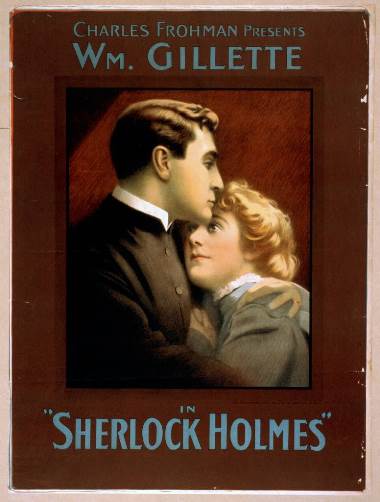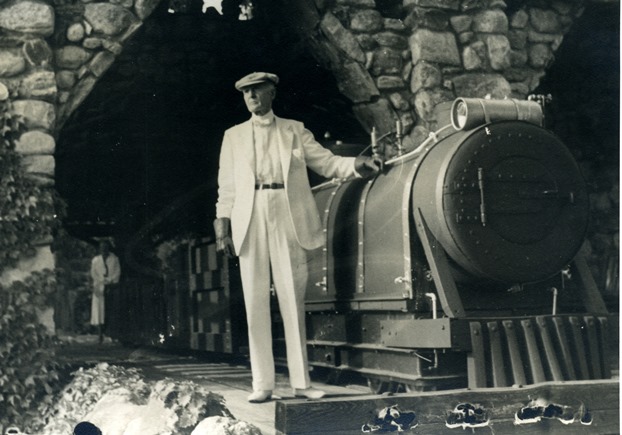By Emily E. Gifford
William Gillette was an American actor, playwright, and stage director most famous for his stage portrayal of Sherlock Holmes and for the extraordinary stone castle he built on a promontory above the Connecticut River in East Haddam. Born in the Nook Farm neighborhood of Hartford, Connecticut, Gillette grew up in a politically progressive atmosphere. His father, former US Senator Francis Gillette, supported reform movements including public education and the abolition of slavery; his mother, Elizabeth Daggett Hooker Gillette, was a direct descendant of Connecticut Colony co-founder Thomas Hooker. The family’s neighbors included Harriet Beecher Stowe and Mark Twain.
As a boy, Gillette built a miniature puppet theater and entertained friends and family with short plays. Along with friends, he co-founded an amateur journal, Hail Columbia, a general interest publication that included articles, stories, puzzles, and jokes and was published regularly for nearly two years (1866–1867). In later years, Gillette credited his Hartford Public High School experiences in English and public speaking with his more “natural” style of acting; in an era of melodrama and actors proclaiming every line, Gillette spoke his lines more conversationally, a style of relative underacting that appealed to audiences ready for something new.
Early Life and Acting
Gillette set his sights on acting, although he did attend, among other schools, both Harvard and Yale universities. While not pleased with his youngest son’s career choice, Francis Gillette, having already lost two adult sons, supported his surviving sons’ career ambitions (William’s brother Edward was a newspaper editor and politician in Iowa).

Poster: Charles Frohman presents William Gillette in “Sherlock Holmes,” 1900 – Library of Congress, Prints and Photographs Division
Gillette’s first professional role, in 1874, was a small speaking part in his neighbor Mark Twain’s theatrical adaptation of The Gilded Age, a novel Twain co-wrote with newspaper editor Charles Dudley Warner. By 1881, theatrical producers Gustave and Daniel Frohman hired Gillette as an actor, director, and playwright; the first play he wrote for them, The Professor, enjoyed a 151-performance run in New York and a national tour.
Not always popular with critics, Gillette focused on pleasing the public. During the 1880s, he experimented with new sound technologies and lighting techniques to enhance the plays he performed in and directed. He also enjoyed a happy personal life. In 1882 he married Helen Nichols and had a highly successful marriage until she died in 1888 of complications from a burst appendix. The couple had no children, and Gillette never remarried.
Gillette Brings Sherlock Holmes to Life on Stage
Gillette continued to work in American theater, eventually crossing the Atlantic to appear in London in 1897, where his play Secret Service was both a critical and commercial success. At that time, Arthur Conan Doyle, creator of the famously eccentric and well-educated detective Sherlock Holmes, found himself in need of money. Having concluded his original Sherlock Holmes stories in 1893, Doyle decided to raise funds by adapting Sherlock Holmes for the stage.
A competing, unauthorized play based on his work further spurred Doyle to action, but he proved unable to write a Holmes play to his own satisfaction. In 1897, Doyle and his agent met with Charles Frohman, one of Gillette’s Broadway associates; Frohman, in turn, suggested Gillette as the perfect person to bring Holmes to life on stage. Doyle agreed and Gillette immediately read Doyle’s Holmes adventures (for the first time) and set to work on the adaptation while on an American tour of Secret Service. In 1899, Gillette traveled to England to show his play, titled simply Sherlock Holmes and drawn from several of Doyle’s stories, to Doyle personally. The two began a longtime personal friendship and a highly profitable professional relationship.
In bringing Sherlock Holmes to life on the stage, Gillette introduced three elements that became synonymous with the famous detective: his deerstalker cap, his long traveling cloak, and his curved briar pipe. Doyle’s Holmes was a Victorian fashion plate who would have worn the first two garments only while in the country; while some illustrations had shown Holmes smoking a straight pipe, Gillette felt that the curved pipe was a better stage prop which, along with the cap and cloak, became distinctive trademarks for the detective. Additionally, Gillette played Holmes as a more arrogant character, often impatient with his colleagues’ inability to keep up with his deductions. Gillette wrote the phrase, “Oh, this is elementary, my dear fellow,” which Clive Brook, the first film Holmes, later edited to “Elementary, my dear Watson.” Neither phrase ever appeared in any of Doyle’s works.
Sherlock Holmes premiered at the Star Theater in Buffalo, New York, on October 23, 1899, and moved to Manhattan’s Garrick Theater on November 6, 1899. While not popular with the critics, audiences loved Gillette’s play and his interpretation of the popular detective. Until Gillette’s final appearance as Holmes on March 19, 1932, nearly 33 years after his first, Gillette appeared as Holmes approximately 1,300 times. Beyond his theatrical performances, illustrations and photographs of Gillette as Holmes circulated widely, and Doyle used Gillette’s Holmes as the model for illustrations of Holmes stories when he began writing new adventures for the detective in 1901.
Gillette Builds a Castle
Gillette made a fortune playing Holmes, and used part of that money, as well as his sense of ingenuity and fun, to build a castle, which he named the Seventh Sister, on property fronting the Connecticut River in East Haddam, Connecticut. Built from Connecticut stone, the castle has 24 rooms, with puzzle locks, secret doors, and even hidden mirrors that allowed Gillette to spy on his guests (including Albert Einstein and Calvin Coolidge) in order to time dramatic entrances for their amusement. The estate, now called Gillette Castle, is owned and maintained by Connecticut’s Department of Energy and Environmental Protection (DEEP). As a state park, it hosts approximately 100,000 visitors a year.

The Seventh Sister now known as Gillette Castle – Harriet Beecher Stowe Center and Connecticut State Library
Millions of mystery lovers around the world who never heard of William Gillette can recognize Sherlock Holmes on sight, largely because of the distinctive wardrobe and mannerisms Gillette created when he interpreted Holmes. Gillette died on April 29, 1937, in Hartford, Connecticut, and received a burial in the Hooker family cemetery in Farmington, Connecticut, next to his wife, Helen Nichols Gillette.
Emily E. Gifford is an independent historian specializing in the history of religion and social movements in the United States.










